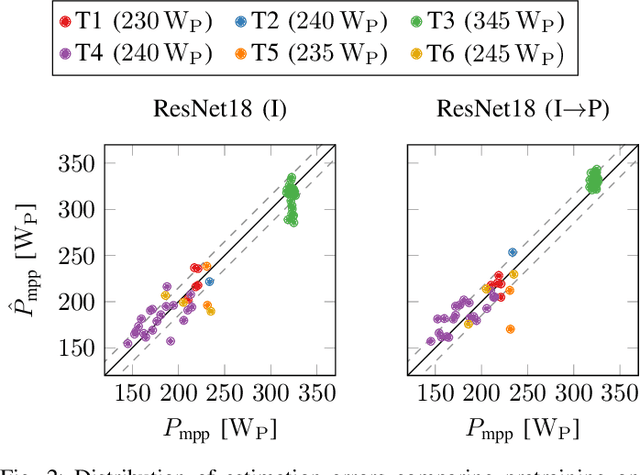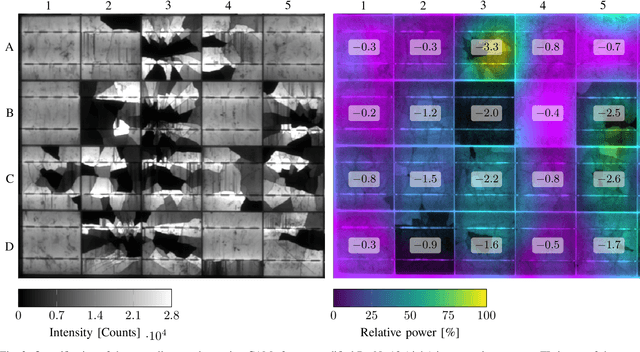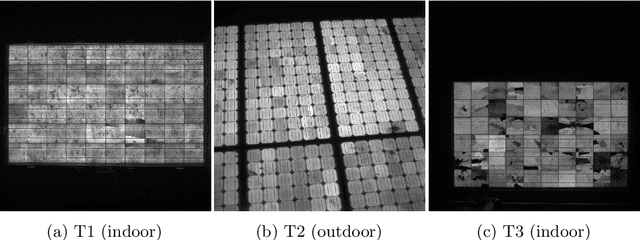Bernd Doll
Module-Power Prediction from PL Measurements using Deep Learning
Aug 31, 2021



Abstract:The individual causes for power loss of photovoltaic modules are investigated for quite some time. Recently, it has been shown that the power loss of a module is, for example, related to the fraction of inactive areas. While these areas can be easily identified from electroluminescense (EL) images, this is much harder for photoluminescence (PL) images. With this work, we close the gap between power regression from EL and PL images. We apply a deep convolutional neural network to predict the module power from PL images with a mean absolute error (MAE) of 4.4% or 11.7WP. Furthermore, we depict that regression maps computed from the embeddings of the trained network can be used to compute the localized power loss. Finally, we show that these regression maps can be used to identify inactive regions in PL images as well.
Joint Super-Resolution and Rectification for Solar Cell Inspection
Nov 10, 2020



Abstract:Visual inspection of solar modules is an important monitoring facility in photovoltaic power plants. Since a single measurement of fast CMOS sensors is limited in spatial resolution and often not sufficient to reliably detect small defects, we apply multi-frame super-resolution (MFSR) to a sequence of low resolution measurements. In addition, the rectification and removal of lens distortion simplifies subsequent analysis. Therefore, we propose to fuse this pre-processing with standard MFSR algorithms. This is advantageous, because we omit a separate processing step, the motion estimation becomes more stable and the spacing of high-resolution (HR) pixels on the rectified module image becomes uniform w.r.t. the module plane, regardless of perspective distortion. We present a comprehensive user study showing that MFSR is beneficial for defect recognition by human experts and that the proposed method performs better than the state of the art. Furthermore, we apply automated crack segmentation and show that the proposed method performs 3x better than bicubic upsampling and 2x better than the state of the art for automated inspection.
Deep Learning-based Pipeline for Module Power Prediction from EL Measurements
Sep 30, 2020



Abstract:Automated inspection plays an important role in monitoring large-scale photovoltaic power plants. Commonly, electroluminescense measurements are used to identify various types of defects on solar modules but have not been used to determine the power of a module. However, knowledge of the power at maximum power point is important as well, since drops in the power of a single module can affect the performance of an entire string. By now, this is commonly determined by measurements that require to discontact or even dismount the module, rendering a regular inspection of individual modules infeasible. In this work, we bridge the gap between electroluminescense measurements and the power determination of a module. We compile a large dataset of 719 electroluminescense measurementsof modules at various stages of degradation, especially cell cracks and fractures, and the corresponding power at maximum power point. Here,we focus on inactive regions and cracks as the predominant type of defect. We set up a baseline regression model to predict the power from electroluminescense measurements with a mean absolute error of 9.0+/-3.7W (4.0+/-8.4%). Then, we show that deep-learning can be used to train a model that performs significantly better (7.3+/-2.7W or 3.2+/-6.5%). With this work, we aim to open a new research topic. Therefore, we publicly release the dataset, the code and trained models to empower other researchers to compare against our results. Finally, we present a thorough evaluation of certain boundary conditions like the dataset size and an automated preprocessing pipeline for on-site measurements showing multiple modules at once.
Fast and robust detection of solar modules in electroluminescence images
Jul 19, 2019



Abstract:Fast, non-destructive and on-site quality control tools, mainly high sensitive imaging techniques, are important to assess the reliability of photovoltaic plants. To minimize the risk of further damages and electrical yield losses, electroluminescence (EL) imaging is used to detect local defects in an early stage, which might cause future electric losses. For an automated defect recognition on EL measurements, a robust detection and rectification of modules, as well as an optional segmentation into cells is required. This paper introduces a method to detect solar modules and crossing points between solar cells in EL images. We only require 1-D image statistics for the detection, resulting in an approach that is computationally efficient. In addition, the method is able to detect the modules under perspective distortion and in scenarios, where multiple modules are visible in the image. We compare our method to the state of the art and show that it is superior in presence of perspective distortion while the performance on images, where the module is roughly coplanar to the detector, is similar to the reference method. Finally, we show that we greatly improve in terms of computational time in comparison to the reference method.
 Add to Chrome
Add to Chrome Add to Firefox
Add to Firefox Add to Edge
Add to Edge